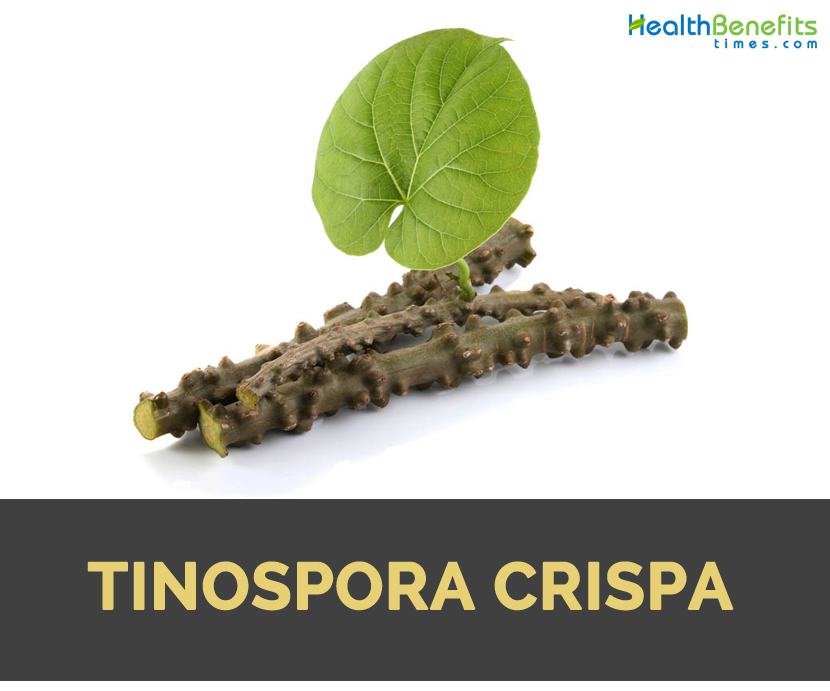Plant Description
Tinospora crispa is a herbaceous vine which grows extensively in subtropical and tropical regions of Southeast Asia. Old stems are fleshy with extended blunt tubercles and younger stems are slightly fleshy, membranous, glabrous and brownish. Leaves are heart shaped about 7-12 cm wide and 6-12 cm long with glabrous petioles about 5-15 cm long. Leaf blades are slightly fleshy with both surfaces being glabrous. Male bloom is very slender about 5-10 cm long. Flowers are six green and glabrous sepals in two whorls. Inner three are obovate and outer three are ovate about 1 mm. It has 3 to 6 yellow color petals and six stamens similar to the length of petals. Female bloom is about 2-6 cm long mostly one flower per node. Fruit is 7-8 mm in length.
Traditional Uses
- A cold infusion of the seed is helpful for intoxication due to alcohol and drugs.
- Infusion made with stem is used to wash aching eyes and syphilitic sores.
- Apply the crushed leaves on wounds or as a dressing for itch.
- Use it to treat septicemia, bruises, scabies, fracture and ulcer related disorders.
- In Malaysia, it is used for hypertension, diabetes, protection from mosquito bites and stimulation of appetite.
- In Bangladesh, juice of stem is used for treating intestinal disorders, rheumatism, jaundice, skin disease, paralysis, body pain and leprosy.
- Use a poultice with coconut oil for treatment of arthritis.
- Powder form or decoction is used for treating fevers, indigestion, stomach trouble and diarrhea.
- Preparation with coconut oil is used as a cure for rheumatism and flatulence in children.
- Use the decoction of stem externally as a wash for tropical ulcers, external parasites, cancerous wounds.
- In Indonesia and Malaysia, infusion made with stem is used as a vermifuge and for treating cholera and diabetes mellitus.
- In Brunei, it is used to treat high blood pressure and abdominal pains.
- Apply the crushed stem’s juice to affected area by scabies.
- For wound healing and tropical ulcers, use the decoction of stem as a wash or soak in oil for 12 hours.
- It is also helpful for athlete’s foot and fertility regulation.
- In Thailand, wood decoction is used for fever, diabetes and lower thirst.
- Use the decoction to treat fever, stomachache, worms and gonorrhea.
Other facts
- It is propagated by stem cuttings or seeds.
- It requires support for climbing.
References:
https://www.frontiersin.org/articles/10.3389/fphar.2016.00059/full
https://www.ncbi.nlm.nih.gov/pmc/articles/PMC4800188/
http://tropical.theferns.info/viewtropical.php?id=Tinospora+crispa
http://www.stuartxchange.org/Makabuhay.html
Comments
| Tinospora crispa Quick Facts | |
|---|---|
| Name: | Tinospora crispa |
| Shapes | 7–8 mm long |
| Name | Tinospora crispa |
|---|---|
| Name in Other Languages | ye qing niu dan, Da ye ruan jinteng, Fa leng teng; French: Liane-quinine; India: Giloya; Malaysia: Akar seruntum, Akar patawali, Patawali; Martinique: Lyann span Zeb kayenn; Thai: Chung ching, Bora phet, Kuakhohoo (Don Daeng), Wan kab hoi yai |
| Plant Size | 4 to 10 meters |
| Stem | 15 meters long, 1 cm thick |
| Leaf | Heart shaped, 6-12 cm long and 7-12 cm wide |
| Flower | Yellow or greenish yellow |
| Fruit shape & size | 7–8 mm long |


